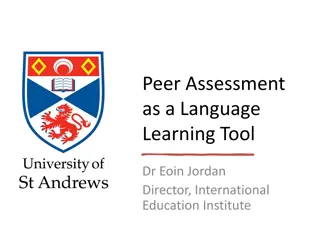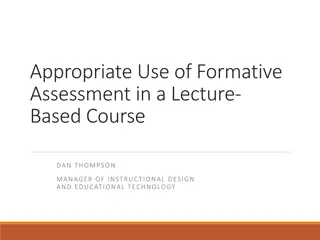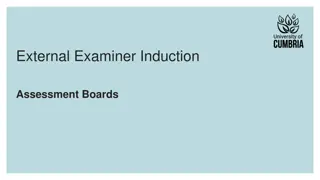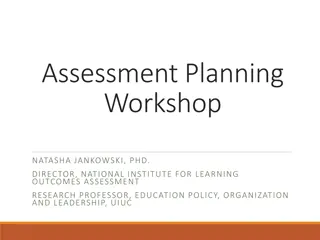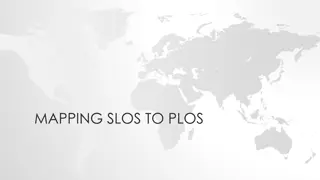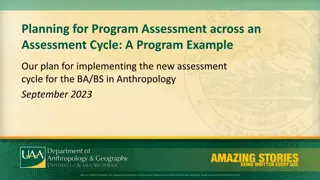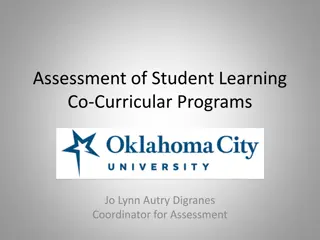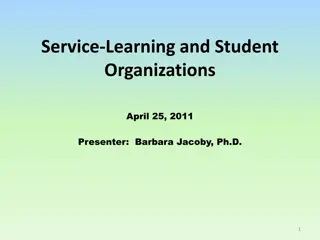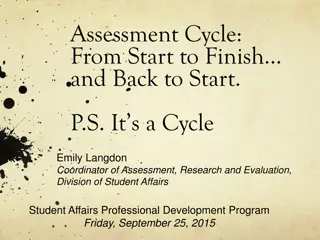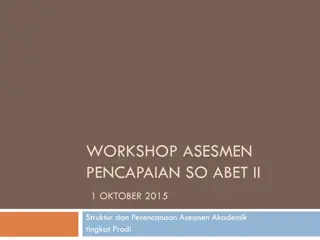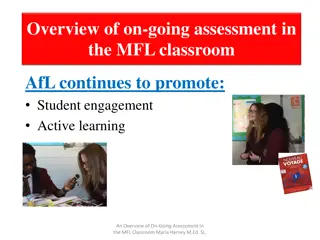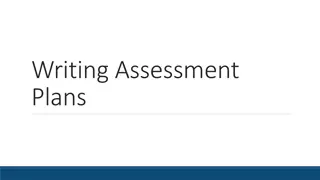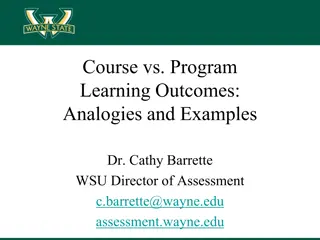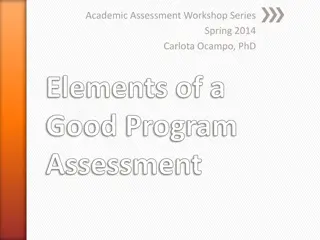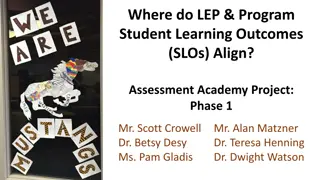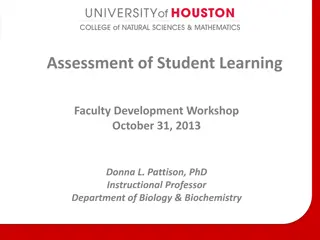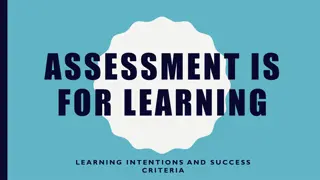Effective Student Learning Outcomes Assessment at the Program Level
Clarify the process for conducting Student Learning Outcomes Assessment at the Program Level by completing a Program Curriculum Map and an Outcomes Assessment Plan. Understand the activities for a 5-Year Cycle, ensure Program Integrity, and learn what to include in a Program Plan. Develop Program Mission & Vision aligned with Institutional Goals, link Learning Goals to Course Outcomes through Curriculum mapping. Collaborate with key stakeholders for successful assessment planning and implementation.
Download Presentation

Please find below an Image/Link to download the presentation.
The content on the website is provided AS IS for your information and personal use only. It may not be sold, licensed, or shared on other websites without obtaining consent from the author.If you encounter any issues during the download, it is possible that the publisher has removed the file from their server.
You are allowed to download the files provided on this website for personal or commercial use, subject to the condition that they are used lawfully. All files are the property of their respective owners.
The content on the website is provided AS IS for your information and personal use only. It may not be sold, licensed, or shared on other websites without obtaining consent from the author.
E N D
Presentation Transcript
Purpose The purpose of this presentation is to clarify the process for conducting Student Learning Outcomes Assessment at the Program Level. At the end of this process you should be able to: Complete a Program Curriculum Map and an Outcomes Assessment Plan.
Overview of Activities for 5-Year Cycle Year 1 Years 2-4 Year 5 Planning Implementation Analysis Revision Analysis and Reporting Program Plan Plan Implementation Compile Program Results Alignment of syllabi Data gathering Analyze Results and Suggest Revisions Assessment and Data Collection Plan On-going analysis *Program Review Evaluation 3
Program Integrity When students leave a program, we want to make sure they possess the knowledge and skills we expect from graduates of that program. To reach those goals we need to make sure students learn those specific learning outcomes. That means each outcome is systematically taught, assessed and monitored to ensure students are making progress toward our program goals. If students are not making progress toward the goals, we want to adapt our program to improve teaching and learning.
What is included in a Program Plan? Program mission and vision Measurable program learning goals Curriculum map Assessment schedule Assessment instruments and scoring criteria Program benchmarks Process for on-going data collection, analysis, and adjustment All of these are developed collaboratively with the Program Coordinator, Advisory Committee (if possible), Discipline Liaison, and full and available part-time faculty members.
Program Mission & Vision A program mission and vision is developed to communicate what the purpose of the program is and what core ideas and values are emphasized in the program. Worksheets to assist in the development of the mission and vision are located in the handbook. This process should be collaborative. The mission and vision must reflect the institutional mission and vision.
Institutional Mission & Vision Institutional Learning Goals Program Mission & Vision Program Learning Goals The link to course outcomes is developed in a curriculum mapping process. Course Outcomes
Program Goals and Outcomes Program goals seek to answer the question, What do we want students to know, be able to do, or be like at the end of this program? These may link to content knowledge, skills, processes, dispositions, etc. Some of these goals will be institutional learning goals.
What should be included in program goals, outcomes, and curriculum maps? The program goals and outcomes should include the entire curriculum for the program. Initially the program goals and outcomes should not be limited to only those outcomes that will be assessed. It should include outcomes that you want to make sure are taught in your program whether they are assessed at the program level or not. Ideally, this process should map outcomes down to the course level. This mapping process goes beyond outcomes assessment planning. Outcomes assessment plans will focus on select goals or outcomes from the entire curriculum map.
Sample Program Curriculum Goals Program Goal Measurable Outcomes I. Management of Health Data I.A. Collect, maintain, and analyze health data. I.B. Apply healthcare information requirements and standards to the organization and accuracy of data The program goal identifies the overall category or desired characteristics of learners I.C. Use, maintain, and validate clinical classification systems The measurable outcomes describe the overall learning goals of the program.
Sample Program Curriculum Goals Program Goal Measurable Outcomes Course Outcomes I. Management of Health Data I.A. Collect, maintain, and analyze health data. I.A.1. Collect and maintain health data (such as data elements, data sets, and databases). I.A.2. Conduct analysis to ensure that documentation in the health record supports the diagnosis and reflects the patient s progress, clinical findings, and discharge status. I.A.3. Apply policies and procedures to ensure the accuracy of health data. I.A.4. Verify timeliness, completeness, accuracy, and appropriateness of data and data sources for patient care, management, billing reports, registries, and/or databases. Ultimately the measurable outcomes are described at the course level. These outcomes should line up with the program outcomes.
What does our Curriculum Map Look Like? Form artistic judgments by exposure to the rich history and diversity of human knowledge and thought Program Student Learning Goals are listed at the top of the column of the Curriculum Map. Demonstrate the basic concepts and practices associated with oral presentations. Identify, locate, and effectively use information from various print and electronic resources. Program Core Courses COM 101 COM 102 COM 120 COM 121 * This presentation will show you how to determine what information goes into these boxes. The name of the core courses are listed on the left-hand side of the Curriculum Map. COM 201
5 Curriculum Map Questions Question 1: Is a particular outcome addressed in a course? Question 2: Are those particular outcomes utilized, taught or assessed in the course? Question 3: What is the level of competence expected on this outcome? Question 4: Where and when will the assessments will be conducted? Question 5: What assessments instruments, scoring tools, and criteria will be used?
QUESTION 1: Is a particular outcome addressed in a course? Form artistic judgments by exposure to the rich history and diversity of human knowledge and thought Demonstrate the basic concepts and practices associated with oral presentations. Identify, locate, and effectively use information from various print and electronic resources. Program Core Courses COM 101 COM 102 COM 120 COM 121 COM 201
QUESTION 2: Are those particular outcomes utilized, taught or assessed in the course? Assessing an Outcome Teaching an Outcome Utilizing an Outcome Assessment of an outcome means that an assessment and scoring tool have been put in place that specifically measure a student s competency on that outcome. Teaching an outcome means that classroom instruction includes specific instruction on knowing or doing this competency. Utilizing an outcome means that students are expected to perform particular knowledge and skill without any formal instruction. The expectation is that the student knows or should know the content or process. For example, a student is not just required to write a paper, but her writing skill is assessed as an element of a rubric. For example, a student is not just ask to analyze internet resources for effectiveness but he is taught a process for analyzing the effectiveness of resources. For example, students in a class are asked to conduct research or write a paper, but no instruction occurs on research or writing skills.
Curriculum Map Form artistic judgments by exposure to the rich history and diversity of human knowledge and thought Demonstrate the basic concepts and practices associated with oral presentations. Identify, locate, and effectively use information from various print and electronic resources. Program Core Courses COM 101 Taught & Assessed Not Utilized COM 102 Addressed COM 120 COM 121 COM 201
QUESTION 3: What is the level of competence expected on this outcome? Evaluation Proficient Synthesis Analysis Developing Increasing Levels of Competence Application Comprehension Emerging Knowledge Bloom s Cognitive Taxonomy
What do Levels of Competence look like? Emerging Developing Proficient A DEVELOPING level means learners are able to go beyond knowledge of the skill or concept to the application of the knowledge or concept in different contexts. Learners still need guidance and feedback as they practice using the knowledge and skills. A PROFICIENT level means learners are able to independently apply the knowledge and skill in a variety of situations. Learners are able to reflect upon their own application of knowledge and skills and make adjustments on their own. EMERGING competence is where knowledge and skills are introduced and where learners are expected to understand the skill or concept well enough to explain a concept or skill.
Curriculum Map Form artistic judgments by exposure to the rich history and diversity of human knowledge and thought Demonstrate the basic concepts and practices associated with oral presentations. Identify, locate, and effectively use information from various print and electronic resources. Program Core Courses COM 101 COM 102 Taught & Assessed Utilized Not COM 120 Addressed Emerging Developing
QUESTION 4: Where and when will the assessments will be conducted? Form artistic judgments by exposure to the rich history and diversity of human knowledge and thought Demonstrate the basic concepts and practices associated with oral presentations. Identify, locate, and effectively use information from various print and electronic resources. Program Core Courses Emerging (Taught) Emerging (Taught) Proficient (Utilized) COM 101 Developing (Taught and Assessed) Spring 2013 Proficient (Taught) Proficient (Utilized) COM 102 Proficient (Utilized) Not addressed Not addressed COM 120 Proficient (Utilized) Developing (Utilized) Proficient (Utilized) COM 121 Proficient (Utilized) Not addressed Proficient (Taught and Assessed) Fall 2001 COM 201
QUESTION 1: Is a particular outcome addressed in a course? QUESTION 2: Are those particular outcomes utilized, taught or assessed in the course? QUESTION 3: What is the level of competence expected on this outcome? QUESTION 4: Where and when will the assessments will be conducted? QUESTION 5: What assessments instruments, scoring tools, and criteria will be used?
QUESTION 5: What assessments instruments, scoring tools, and criteria will be used? Once the team has selected the outcomes for outcomes assessment, the assessment instruments and scoring tools should be collaboratively developed. The criteria for success should then be discussed and explained. These elements make up the final portion of the outcomes assessment plan.
Conclusions There should be a link between institutional, program, and course outcomes. Teamwork is essential. Program Coordinators will lead this process but Discipline Liaisons and faculty members will work together on this process. Curriculum mapping is the first step. It looks at all outcomes. Program Outcomes Assessment aims to answer the question, How well do our students demonstrate particular knowledge, skills, and dispositions as a result of the program?


